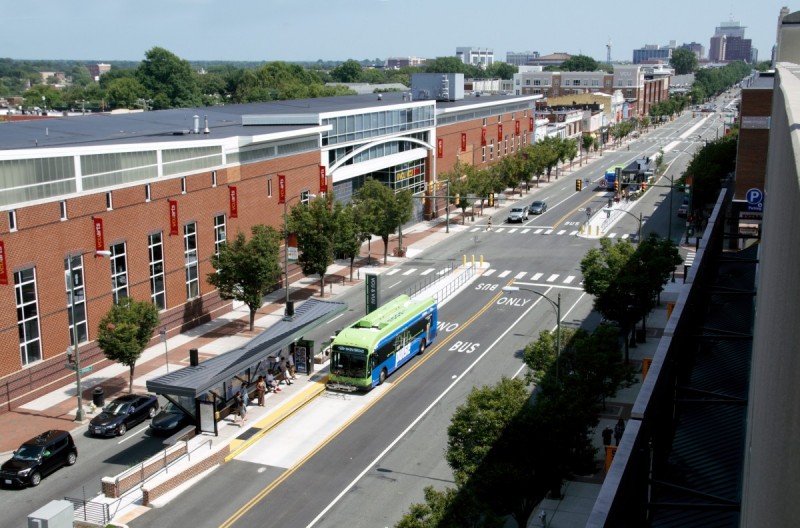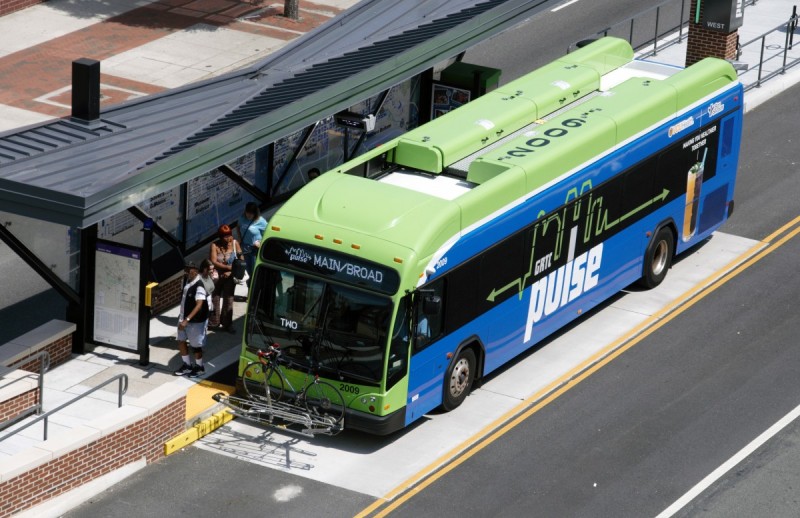Take a photo tour of Richmond’s new Bus Rapid Transit

Richmond's new Pulse BRT. Image by the author.
On June 24, 2018, the Pulse BRT opened along Richmond's Broad Street corridor. It's the second bus rapid transit line in Virginia, and the first in Richmond. I recently visited, and naturally nerded out, camera in tow.
The Pulse's 7.6 mile route has 14 stops and runs in a mix of curbside bus lanes, median busway, and mixed traffic with cars. Most of the line runs along Broad Street, Richmond's highest-ridership transit corridor.
Route map. Image by GRTC.
West of downtown Richmond, the Pulse runs in an impressive median busway—bus lanes and stations set in the middle of the street.
This image and all further images are by the author. 
Stations are spaced widely apart, so buses don't stop every block. Eastbound and westbound stations are separate from each other, which reduces the amount of street space the BRT takes up, and allows for right-door boarding all the time.
It's a clever layout that's different from Metroway's double platforms, and from the double-sided center stations in places like Cleveland that require left-side bus doors.
Bus only signals give buses priority, and protect them from left-turning cars.
Where local non-BRT buses join Broad Street for a few blocks at a time, they don't use the busway, instead sticking to the general purpose lanes.
In downtown Richmond the median busway ends, and both the BRT and local bues use curbside bus lanes.
East of downtown and on the far west end of the line, Pulse buses run in mixed traffic with cars.
Pulse stations look and function more like light rail stops than bus stops. They have a uniform design, high platforms, and quality rider amenities.
A bumper guideway helps with level boarding. Bus drivers manually drive the bus up against the platform until the wheels bump against the bumper, and they know they're as close as possible. It's a much lower tech version of the laser system that guides some other BRT lines, like in Las Vegas.
The station architecture includes wayfinding information. The back wall doubles as a map of the corridor.
QR codes link to info about each station.
Platform signs hold more traditional maps.
They include simple language explanations of bus frequency.
Riders pre-pay their fares at the station. Fare machines handle cash, credit, or tap cards.
Riders can also pre-pay via mobile app.
Riders access busway stations via crosswalks at the intersections.
Curside stations are right up on the sidewalk.
A few stations have RVA Bikeshare docks nearby.
The Pulse uses specially branded 40-foot long buses.
All Pulse buses stop at all Pulse stations, so passengers never pull cords or push buttons to request stops. In fact, stop-request cords and buttons are completely absent from the buses.
Buses do have clear, simple strip maps.
What do you think?






















